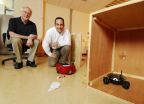(Press-News.org) An innovative grouping of conservation scientists and practitioners have come together to advocate a fundamental shift in the way we view biodiversity. In their paper, which was published today in the journal Science, they argue that unless people recognise the link between their consumption choices and biodiversity loss, the diversity of life on Earth will continue to decline.
Dr Mike Rands, Director of the Cambridge Conservation Initiative and lead author of the paper, said: "Despite increasing worldwide conservation efforts, biodiversity continues to decline. If we are to make any kind of impact, it is critical that that we begin to view biodiversity as a global public good which provides such benefits as clean air and fresh water, and that this view is integrated not just into policies but also into society and individuals' day-to-day decisions."
The conservationists, from conservation organisations as well as academia, recognise that biodiversity loss is typically the result of unintended human actions and therefore raises unique difficulties. They state, "The impacts of a particular action are often distant in space and time. This makes effective regulation difficult, as no single body has jurisdiction over the world's biodiversity."
As part of a solution, the authors advocate managing biodiversity as a global public good. They argue that an appreciation of biodiversity as a public good with economic and societal value, providing benefits that far outweigh the cost of conserving ecosystems, should be central to all policy making that impacts on the environment.
They believe it is essential that biodiversity not be considered in isolation as part of the nation's environmental agenda, but must extend across all sectors of government from treasury to defence. This is especially important as some of the policies that most damage biodiversity, such as agricultural, transport and energy subsidies, are not overseen by most governments' environmental regulators.
Internationally, they stress the need for greater support to conservation efforts in developing countries that are rich in biodiversity, including the crucial task of building institutional capacity (the strengthening of the institution through improved regulations, governance and organisational support)
They advocate for economists and conservationists to work more closely together with policy makers to develop strategies that use incentives and regulations to shift individuals, governments, businesses and civil society toward more biodiversity-friendly behaviour.
Dr Rands continued: "Valuing biodiversity is vital to changing the way we view this important resource. Because we have received the benefits of biodiversity for free, we take it for granted. The costs of conserving biodiversity are massively outweighed by the benefits. As the United Nations General Assembly meets for a special session to discuss biodiversity, this is an especially timely and important message for world leaders to take on board.
"It is critical we incorporate the view of biodiversity as natural capital into management decisions and, more importantly, public policies which reward positive individual actions and penalize negative ones."
The paper emphasises this point, stating, "The value of biodiversity must be made an integral element of social, economic and political decision-making, as is starting to happen with carbon and climate change. Government, businesses, and civil society all have crucial roles in this transition."
Currently, the key pressures driving biodiversity loss are the degradation, fragmentation and destruction of habitats, pollution, overexploitation of species, invasive species and climate change.
As these pressures on biodiversity increase, the number of species faced with extinction continues to rise, with 21 per cent of all known mammals, 30 per cent of all known amphibians, and 12 per cent of all known birds* under threat. Additionally, nearly a quarter of plant species are believed to be at risk.**
INFORMATION:
*According to the 2009 IUCN Red List
**According to Global Biodiversity Outlook 3
For additional information please contact:
Genevieve Maul, Office of Communications, University of Cambridge
Tel: direct, +44 (0) 1223 765542, +44 (0) 1223 332300
Mob: +44 (0) 7774 017464
Email: Genevieve.maul@admin.cam.ac.uk
Notes to editors:
1. The paper 'Biodiversity Conservation: Challenges Beyond 2010' by Rands MRW, Adams WM, Bennun L, Butchart SHM, Clements A, Coomes D, Entwistle A, Hodge I, Kapos V, Scharlemann JPW, Sutherland WJ & Vira B will be published in the 10 September 2010 edition of Science.
2. The Cambridge Conservation Initiative (CCI) is a pioneering collaboration between six Departments of the University of Cambridge and nine leading conservation organisations (including United Nations Environment Programme World Conservation Monitoring Centre, BirdLife International, Fauna and Flora International and the British Trust for Ornithology) based in the Cambridge area. It represents a critical mass of expertise at the interface of research and education, policy and practice for the conservation of biodiversity and ecosystems.
END
The lure of greater profits elsewhere in the world may divert bio-pharmaceutical firms in developing countries from the creation and distribution of affordable drugs, vaccines and diagnostics for illnesses of local concern, undermining the health prospects of millions of poor people, experts warn.
And they call for a series of measures to bolster international support for continuing the success of firms finding homegrown solutions to immediate health concerns in developing countries.
In a commentary published by the journal Nature Biotechnology, researchers Rahim Rezaie ...
University of California, Berkeley, researchers have taken genes from grass-eating fungi and stuffed them into yeast, creating strains that produce alcohol from tough plant material – cellulose – that normal yeast can't digest.
The feat could be a boon for the biofuels industry, which is struggling to make cellulosic ethanol – ethanol from plant fiber, not just cornstarch or sugar – economically feasible.
"By adding these genes to yeast, we have created strains that grow better on plant material than does wild yeast, which eats only glucose or sucrose," said Jamie Cate, ...
NAIROBI (9 September 2010)—Greenhouse gas emissions caused by livestock operations in tropical countries—a major contributor to climate change—could be cut significantly by changing diets and breeds and improving degraded lands, according to a new study published this week in the U.S. Proceedings of the National Academy of Sciences. And as an added bonus, scientists found the small changes in production practices could provide a big payoff by providing poor farmers with up to US$1.3 billion annually in payments for carbon offsets.
"These technologically straightforward ...
Liquid water has interacted with the Martian surface throughout Mars' history, measurements by NASA's Phoenix Mars Lander suggest.
The findings, published in the Sept. 10 issue of the journal Science, also suggest that liquid water has primarily existed at temperatures near freezing, implying hydrothermal systems similar to Yellowstone's hot springs on Earth have been rare on Mars throughout its history.
These surprising results come from measurements Phoenix made in 2008 of stable isotopes of carbon and oxygen in the carbon dioxide of the Martian atmosphere. Isotopes ...
URBANA – In the search for the perfect crop for biofuel production, Miscanthus has become the darling to many. But in an effort to not be charmed by its enormous potential for biomass production, researchers at the University of Illinois are taking a careful look at the pros and cons of its behavior in the field.
A recent study analyzed water quantity and quality in plots of Miscanthus, switchgrass, corn, and soybeans and found that Miscanthus used substantially more water, but reduced the potential for nitrogen pollution to water bodies.
"We found that Miscanthus ...
A robot deceives an enemy soldier by creating a false trail and hiding so that it will not be caught. While this sounds like a scene from one of the Terminator movies, it's actually the scenario of an experiment conducted by researchers at the Georgia Institute of Technology as part of what is believed to be the first detailed examination of robot deception.
"We have developed algorithms that allow a robot to determine whether it should deceive a human or other intelligent machine and we have designed techniques that help the robot select the best deceptive strategy to ...
OTTAWA – September 9, 2010 --- New analysis of a landmark health survey by the University of Ottawa Heart Institute (UOHI) shows that 70% of Ontario adults are either overweight or obese, and have a strong prevalence of high blood pressure that could lead to heart attack or stroke.
The research, led by Dr. Frans Leenen of the Heart Institute's Hypertension Unit, adds new information to a limited amount of Canadian data on obesity and high blood pressure. The analysis further strengthens the link between high blood pressure and above normal Body Mass Index (BMI), a formula ...
AUSTIN, Texas—People are more likely to remember specific information such as faces or words if the pattern of activity in their brain is similar each time they study that information, according to new research from a University of Texas at Austin psychologist and his colleagues.
The findings by Russell Poldrack, published online today in the journal Science, challenge psychologists' long-held belief that people retain information more effectively when they study it several times under different contexts and, thus, give their brains multiple cues to remember it.
"This ...
It's no secret: the United States is in the thick of a "green trend." Increased awareness of and commitment to sustainability and improving the environment through reduced carbon emissions and energy use have led to more consumer demand for "green" products, including green construction. Even with the downturn in the housing market, a 2008 poll showed that 91 percent of registered voters nationwide would still pay more for a house if that meant a reduced impact on the environment.
The same is true for the commercial building industry, as construction companies prioritize ...
Johns Hopkins researchers have determined why certain stem cells are able to stay stem cells.
The report in the June 4 issue of Cell Stem Cell reveals that an enzyme that changes the way DNA is packaged in cells allows specific genes to be turned on and off, thereby preventing a stem cell from becoming another cell type.
Each cell has to fit in 6 feet of highly organized and carefully packaged DNA. Some regions of the DNA are more tightly compacted than others and this structure is dynamic. There are specific enzymes that change how condensed the DNA is to help turn ...




